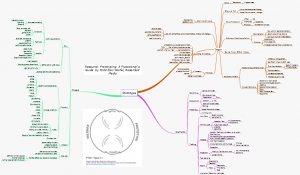At some point and time, you have to turn your idea into a reality. The best way is to get feedback as early as possible even at the pen paper stage, Your First Prototype is with Pen and Paper. Most of us are bias about our idea and even in the way we perceive and interpret the data. This is why having a structured approach to prototyping is imperative. Without one, we typically see what we want to see. As a result, we gain confirmation versus additional knowledge.
You must be very open to feedback at this stage. You must welcome complaints and criticisms from others. If you take an honest and positive approach in gaining feedback from others, you will have increased your odds of success and gain the valuable information needed.
The instinctive type approach is surprisingly rather closed to alternatives. As a result the outcome is frequently flawed or less effective than a structured approach. In The Thinker’s Toolkit: 14 Powerful Techniques for Problem Solving book outlines six steps of the problem with intuitive problem solving:
- We commonly begin our analysis of a problem by formulating our conclusions; we thus start at what should be the end of the analytic process.
- Our analysis usually focuses on the solution which we intuitively favor; we therefore give inadequate attention to alternative solutions.
- The solution we intuitively favor is more often than not the first one that seems satisfactory.
- We tend to confuse “discussing/thinking hard” about a problem with “analyzing” it (these2 activities are not at all the same).
- We focus on the substance (evidence, arguments, and conclusions) and not on the process of our analysts.
- Most people are functionally illiterate when it comes to structuring their analysis.
If people have not learned and understood problem solving techniques, they cannot formulate a reasonable conclusion. It is a guess and a reaction based simply on intuition. Building the prototype is the easy part. Breaking them, testing them and learning from them is the important part. In a recent read, Prototyping: A Practitioner’s Guide, I found author Todd Warfel description of the process outstanding. Though the book may lend itself more to the UI/UX/IX and other software designers, I found the book fascinating and so grounded in foundational principles that I would recommend it for anyone. The majority of the Mindmap below is a result of my interpretation of the book.
 If you would like to download the PDF, Prototype.
If you would like to download the PDF, Prototype.
The reporting process I recommend for most prototyping is using a basic A3 for structure. This way you outline your process in a clear and concise manner.
Related information:
Why Prototype? Customer Interactivity is the Most Meaningful Part of Design
Prototyping into a Working Form
Prototypes provide a Pathway for Connecting with Customers
A Product Marketers perspective on Prototyping
